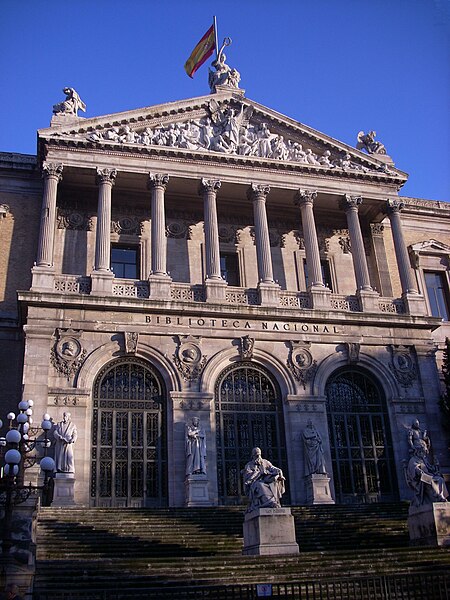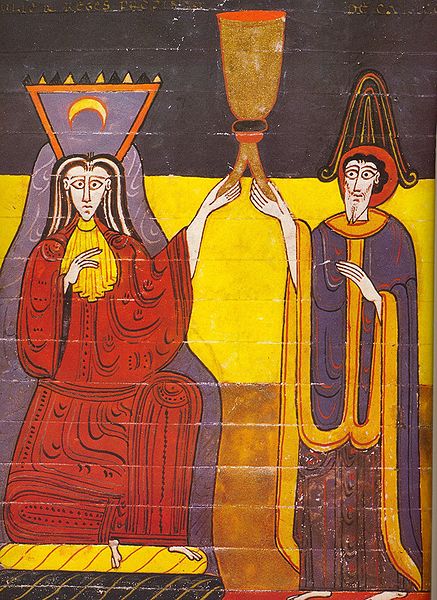
National Library, Spain
The National Library of Spain (Biblioteca Nacional de España or BNE) is located in Madrid, the capital and largest city of Spain. The library was established by King Philip V in 1712 as the Palace Public Library (Biblioteca Pública de Palacio). In the 1830s, it was renamed the National Library. The current building of the BNE was opened in the 1890s. Its Articles of Association, passed by Royal Decree 1581/1991 (R.D. 1581/1991) of October 31, 1991, declare that its principal functions are to
- compile, catalogue and conserve bibliographic archives produced in any language of the Spanish state, or any other language, for the purposes of research, culture and information.
- promote research through the study, loan and reproduction of its bibliographic archive.
- disseminate information on Spain’s bibliographic output based on the entries received through the legal deposit requirement.
The BNE owns about 35 million items, including more than 16 million books and other printed materials, 30,000 manuscripts, 143,000 newspapers and serials, 4,500,000 graphic materials, 510,000 musical scores, 500,000 maps, 600,000 sound recordings, 90,000 audiovisual materials, 90,000 electronic documents, and more than 500,000 microforms.
Each month some 65,000 items are added to the BNE collection, of which about one fourth are books. Among outstanding collections are the Spoken Word Archive, containing recorded voices from the past and present of outstanding scientists, artists, and others, as well as lectures, language courses, stories, and other materials. These range from recordings of jokes in Spanish from over 100 years ago and spoken word recordings by important Spanish-language authors from other countries, such as Gabriel García Márquez, Ernesto Sábato, Nicolás Guillén, and Pablo Neruda, some of whom are represented in the collection of the Thammasat University Library.
The BNE’s collection of Ephemera assembles graphic materials that were only made for temporary use and not intended to be preserved by history. Even so, these items have meaning for historians, sociologists, and other researchers. They include advertising labels and wrappings designed by graphic illustrators to decorate all types of packaging that provide information about the content, quality, and properties of a product, instructions for use, and other essential information.
A further collection of Posters includes material from the 1800s, including advertising and political announcements, some by noted artists such as Josep Morell, Ramón Casas, Rafael de Penagos, and Josep Renau.

The director of the BNE is Ana Santos Aramburo. Ms. Santos Aramburo earned a degree in geography and history from the University of Zaragoza and a diploma in library science and documentation from the Documentary Studies Center of the Ministry of Culture, with a thesis on Artistic Documentation in the Archive of Notarial Protocols of Zaragoza in the 17th century.
In March 2007, she was appointed Director of Cultural Action of the BNE. She worked to improve outreach to readers and making the library’s services and collections more available, designing and planning the library’s annual exhibition program as well as lectures and seminars about the world of books. She was also responsible for activities aimed at diffusing better understanding of the library and overall increased openness to Spanish society. She helped launch the Museum of the National Library of Spain.
This museum attempts to unify the wide range of materials that the library has collected over the centuries, including paintings, sculptures, furniture, musical instruments, mechanical music devices, typewriters, and industrial instruments related to the arts of the book.
She told Spanish radio last year that the BNE must be permanently alive… There is a kind of respect imposed by the building and we are working to give the idea of openness that we are seeking to express and that we think the National Library should have… Immensely precious resources are preserved there and those resources must be at the service of all citizens.
Her favorite parts of the BNE are the general reading room and the entrance hall in the morning when it is full of school groups, when there are guided tours, when there are young people, when I see it full of life, I love that, because the BNE has to be permanently alive.
Ms. Santos Aramburo has been active in preserving digital resources for the BNE, adapting a law in 2015 to pertain to digital materials: It is very important that it exists because on the internet things are created and disappear very quickly.
In 2015, she explained to El Diario newspaper about cultural policy, pointing out that inhouse employees of the BNE represented a significant saving in terms of budget, compared to outsourced workers. In past years many problems were caused by outsourcing library projects. With a reduced budget, Ms. Santos Aramburo told the interviewer, it was necessary
to manage with little and the results are good. We have adapted the income to the expenses. We look at the last euro, since this is a public budget that comes from the taxes of all Spaniards, and we must get the maximum return on that investment. That is, it is about achieving maximum efficiency. And I believe that public managers must perform an exercise of responsibility towards society, especially at this time. The catalogs we have now are not as luxurious as before, the organization of exhibitions is not as opulent as they were before, but it is all very dignified, and the exhibitions are very successful. We also have grants… Personal bequests have increased. More people constantly come to us to donate their books, manuscripts, and personal files, otherwise we could not have them. The value of such donations in 2014 was around one million euros. It is an important economic value, but above all part of our heritage, because it is deposited in a public institution that is in the service of all.

Ongoing digitization efforts
In addition to an extensive digitization project of millions of pages of material, the BNE is focusing on listening to staff and reader input. All indications are that book circulation has increased, as have the number of library cards being issued, the number of annual visitors to the BNE, and use of all the digital services. A five-year strategic plan looks to a brighter future for the BNE.
Exchanges with Spain
Last July, The Nation reported that Spain’s La Liga football league invited the Wild Boars football team, whose rescue from a cave in Chiang Rai drew international attention and assistance, to visit Spain in order to see a match and watch many of their football heroes in action in person. One of the boys wore a Real Madrid t-shirt, showing support for the Spanish professional football club based in Madrid.

(All images courtesy of Wikimedia Commons)
